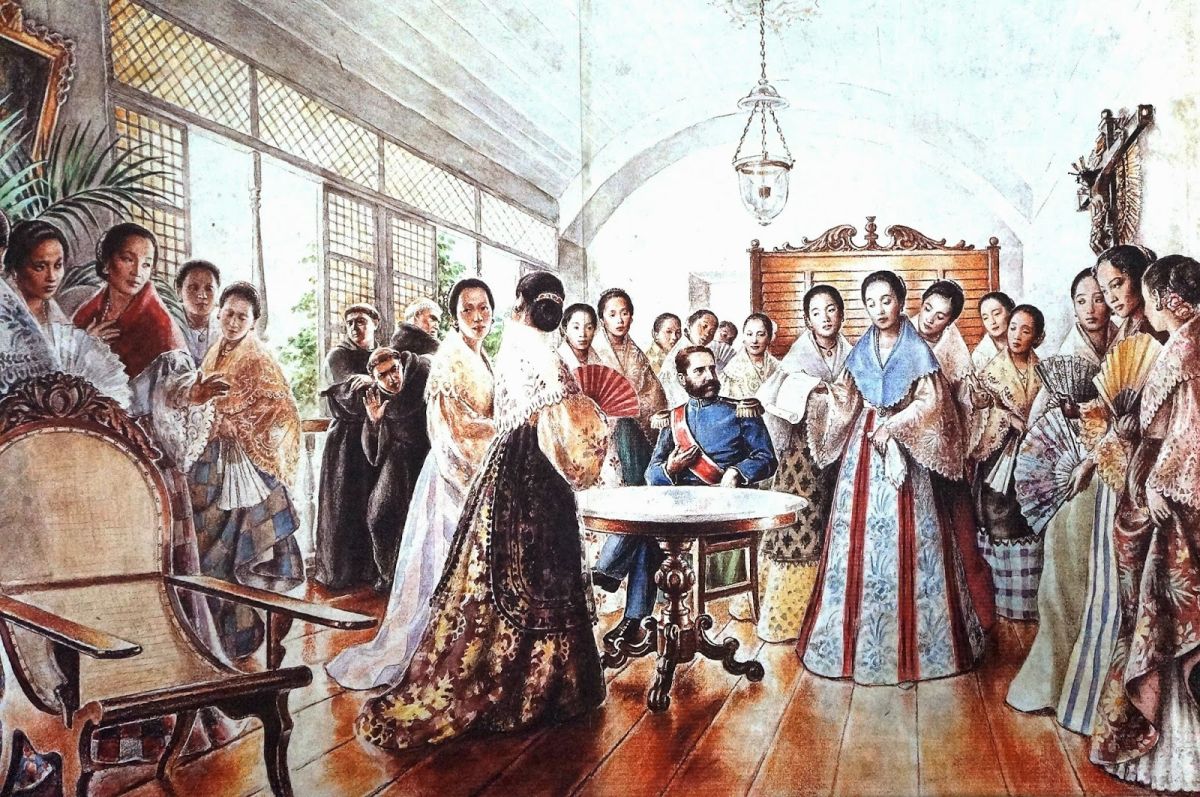Ang Mga Kababaihan ng Malolos
Interactive Object: Itapat ang cursor sa mga karakter sa larawan at pindutin upang madala ka sa mga kaugnay na pahina.
Who were the 20 women of Malolos?
by Gemma Cruz Araneta
They wanted to open their own night school and hire a professor to teach them Spanish. To the Agustinian parish priest it was an act of defiance; to Marcelo del Pilar, Graceano Lopez Jaena and Jose Rizal, Filipino women were throwing off colonial shackles. Rizal was overjoyed that there were women like them in the Philippines. He wrote them a letter in Tagalog in February 1889.
Elisea Tantoco Reyes (1873) and her younger sister, Juana (1874) were daughters of Gobernadorcillo Jose Tiongson Reyes, a reformist constantly harassed by the Spanish colonial government.
Basilia Villariño Tantoco (1865) was homeschooled. Her father, Gabino, her five brothers and uncle Agustin were Katipuneros; she was initiated into the secret society by her father. The Tantoco home was the Secretaría de Hacienda (Department of Finance) of the First Republic that was taking form in Malolos.
Basilia’s second cousins, Eugenia (1871) and Aurea (1872) were daughters of Gobernadorcillo Tomas Tantoco (1879) who became Justice of Peace from 1887 to 1889. Their mother, Rosenda, alumna of Colegio de la Concordia in Manila was a friend of Fr. Jose Burgos. Aurea married Eugenio Hernando, a doctor of the Spanish forces who defected to the Philippine Revolutionary Army in 1898.
Leoncia Santos Reyes (1864), aunt of Elisea and Juana Tantoco Reyes, spoke Spanish fluently and was a property owner at 17. She married a primary school teacher, Graciano Tiongson Reyes, her first cousin.
Rufina Tengco Reyes (1869) , first cousin of Elisea and Juana Tantoco Reyes, and niece of Graciano Tiongson Reyes, the primary school teacher Leoncia married. The 20 women opened the school in Rufina’s house.
Olympia San Agustin Reyes (1876), half-sister of Leoncia Santos Reyes, was a precocious 12- year old when they “ambushed” Gov. Valeriano Weyler. She married Vicente Tantoco Reyes, brother of Elisea and Juana.
Teresa Tiongson Tantoco (1867) and younger sister Maria (1869) were cousins of the two Basilias and of Eugenia and Aurea Tanchanco. Maria married cabeza de barangay, Lino Santos Reyes. The Tantoco home was the Department of Foreign Affairs of the First Republic.
Anastacia Maclang Reyes (1874) was first cousin to Teresa and Maria Tantoco and second cousin of sisters Eugenia, Aurea and Basilia Tantoco. The whole family would send food and other supplies to the Philippine Revolutionary Army.
Basilia Reyes Tiongson (ca. 1860) , the oldest of the 20 women, was the daughter of reformist Antonio Morales Tiongson and Juliana Reyes. Marcelo del Pilar was a personal friend. Maria Tantoco and Anastacia Tiongson were her first cousins.
Aleja Reyes Tiongson (ca. 1864) was the younger sister of Basilia and Paz. Very little is known about her.
Paz Reyes Tiongson (ca. 1862) was quite sickly, so was unable to attend the school they fought for so relentlessly.
Mercedes Reyes Tiongson like older sisters Basilia, Paz and Aleja sent supplies to the katipuneros. When her father and older siblings died, she took over the management of their lands. She married Teodoro Sandico who became governor and senator.
Agapita Reyes Tiongson (1872) , like her sisters, provided food for the Philippine Revolutionary Army. She studied at the Colegio de Santa Isabel and was married late, at 42, to Francisco Batungbakal. They were childless so Agapita raised a goddaughter as her own.
Filomena Oliveros Tiongson (1865) was the third cousin of Mercedes and Agapita Reyes Tiongson, Anastacia Maclang Tiongson and the Tantoco sisters, Teresa and Maria. In 1889, the parish priest accused her and sister Cecilia of eating meat on Holy Thursday, of rarely going to church and infrequent confessions. Filomena helped the Katipunan and the Malolos Republic. In 1896, with husband (Eladio Adriano) and her sisters, they petitioned Governor-General Camilo Polavieja for clemency for Jose Rizal. Filomena and Rizal’s sisters became close friends.
Cecilia Oliveros Tiongson (ca. 1867), Filomena’s younger sister, was known for her sharp tongue. In 1889, the newly- appointed friar curate of Malolos asked the gobernadorcillo to invite the Tiongson sisters to the convent, Cecilia lashed at the hapless local official and accused him of soliciting women for the priest. She too became a close friend of the Rizal sisters.
Feliciana Oliveros Tiongson (ca. 1869), like her elder sisters Cecilia and Filomena, pleaded for Rizal’s life. Her last years were spent teaching children religion, reading and arithmetic.
Alberta Santos Uitangcoy (1865), first cousin of Leoncia Reyes, received higher education in La Concordia. With Basilia Tantoco and Mercedes Tiongson, she handed the letter signed by the 20 women to Governor-General Valeriano Weyler. She married cabeza de barangay, Paulino Reyes Santos and had nine children. Like the other 19 women, she remained socially involved after fighting two empires, the Spanish and American, in defense of Philippine independence. Only three of the original 20 women of Malolos were alive when Japan invaded the Philippines.
References: [edit]
- Araneta, G. C. (2022, December 15). Who were the 20 women of Malolos? Manila Bulletin.
https://mb.com.ph/2022/12/14/who-were-the-20-women-of-malolos
- Gota De Leche Manila, Woman of Malolos. Retrieved from:

